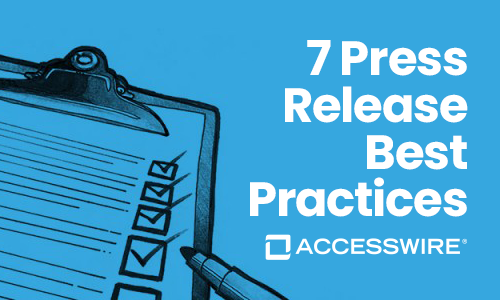Digital Newsroom Structure: A Guide
In the Internet era, the digital newsroom is one of the most important tools of public relations. It is a reservoir of information where reporters can head to cull the raw materials for their reportage. These materials may include:
- Press release
- Company and industry news
- Owned and earned media assets
- Facts, stats, and data sheets
- Company and leadership bios
How you tailor your digital newsroom structure determines whether your stories get picked up and whether your media contacts will take their business elsewhere.
This guide will outline the essential features of a dynamic online newsroom and how to structure your digital press hub to leverage your business’ interests while resolving the modern demands placed on media companies or journalists across the media industry.
Why Have a Digital Newsroom?
Whatever the nature of the story, journalists and the organizations they cover have always had a symbiotic relationship. Companies rely on journalists to gain credibility and reach a wider audience; journalists depend on companies to provide the “meat” of the stories they write. The advent of the internet has yielded dramatic changes to both digital journalism and the entities they write about:
- Decreased resources, escalating output – Even as journalists’ resources and funding continue to nosedive, the expectations for content output and turnaround have never been higher. This conflict opens the door for brands to put the raw material for journalist’s stories at their fingertips, saving media personnel time, energy, and resources.
- Two-way traceability – Because most research nowadays is executed online, companies with digital news hubs can exercise their data analysis faculties to track where site visitors are coming from, which discovery routes they took, and what stories are resonating.
- The reign of visual media – The internet has incited an increasing demand for visual images while dwindling funds have limited press outlets’ ability to produce their own news media. As such, journalists at a news organization rely on brands to source their content—giving brands a leg up in shaping brand awareness to their advantage.
There’s no denying that the rapid digitization of culture and industry has put tremendous pressure on every industry. Even so, every monumental shift comes with drawbacks and golden opportunities.
Not only does creating a corporate online newsroom assuage the myriad constraints placed on modern media—but it also gives your organization an unprecedented opportunity to frame the stories they tell about you.
Structuring Your Digital Newsroom: 5 Essential Features
There are five key limbs every organization should incorporate into its digital newsroom structure, whether your company is geared toward kindling media interest, B2B engagement, B2C engagement, or meeting your nonprofit goals.
#1 Contacts
The number one complaint among journalists regarding corporate newsrooms is a lack of transparency.
No matter how many media assets you populate your corporate newsroom with, reporters aren’t interested in merely repurposing the media you provide. Their job is to tell a more nuanced story, so it’s essential to keep your online newsroom updated with current, easy-to-find contact information for a company representative.
Providing direct lines to members of your organization is essential for building relationships with every kind of digital newsroom visitor, from industry peers to possible donors.
Minimize the work visitors have to do to reach out: if you have multiple PR professionals in your business, be sure to identify which individual manages which sectors of your business. That way, newsroom visitors don’t waste time trying to navigate for themselves.
#2 Content
If you’ve ever visited a website from before 2010, you likely understand how media can gravely offend the senses.
Investing in high-resolution, competitive-quality images and multimedia is no longer considered superfluous—it’s essential. Consider supplying your online press room with the following:
- High-resolution photography of leadership, products, and company events
- Up-to-date and easy-to-read data, infographics, and statistics
- High-quality videos describing your brand’s mission and vision
- Earned media assets and press coverage
The internet is a highly visual medium, and journalists at a news organization may sideline your company if you don’t pave the way for them to illustrate their story. The best way to do this is to provide your journalists with pre-packaged press or media kits. So, what is a press kit, exactly? A press kit is a set of promotional information that gives the media background on a company. If you’re unsure how to make a press kit, each one should include:
- A summary of your company, your leadership, and your mission
- High-resolution company media (logos, photography, and video)
- List of any company awards, grants, or accolades
- Official press release
- Contact information for a company representative
Lastly, it’s important to show that your company is a dynamic agent in your industry and actively involved in the machinations of your field.
Use your digital newsroom to announce any upcoming events, keynotes, and conferences your organization is participating in. Not only will this keep your readers up to speed on your operations, but it’ll give reporters an arc to follow, an opportunity for in-person outreach, and concrete touchpoints for staying up-to-speed on your organization’s activities.
#3 Context
By curating a compelling gallery of industry news, you’ll establish where and how your company fits into the larger scheme of your industry. Furthermore, framing your activities in the field supplies the journalist or reporter with more compelling, variegated angles from which to tell a potential story.
What’s more, you’ll establish your organization as a credible voice in your field—one that can be used as a resource for future stories about your industry, whether or not the piece is about you specifically.
#4 Commentary
While context lays the backdrop of where your organization lies in your industry writ large, spotlighting key commentary from other figures and corporations in your field can be a valuable means of elaborating on your brand’s mission.
Consider whether your company has been involved in any panels, summits, or industry events. Are there any partners, affiliates, and experts in your field that align with your company’s vision and goals? Choose the commentary you publish to your newsroom with discretion, and be sure to feature current voices—ideally from within the past 5 years.
#5 Search Capabilities
We’ve already emphasized the importance of providing media kits in your online press room, but to make these provisions effective, it’s dually necessary to ensure search capabilities are integrated into your digital newsroom structure.
A whopping 80% of journalists report exasperation when trying to find the resources and media they need to fill out their reportage.3 Ping-ponged email back-and-forths that are weighed down with media downloads and file shares place an exorbitant burden on bandwidth—literally, and with respect to the reporter’s time.
To cut unnecessary time spent scrolling—and to shore up your news media relations—make sure your press hub is fully furnished with search capabilities.
Fomenting a Progressive Digital Newsroom Strategy
The aforementioned elements of successful digital newsrooms should all work in concert with your organization’s predetermined PR strategy. At ACCESSWIRE, we’ve learned that progressive public relations strategies are driven by five non-negotiable operations:
- Synchronizing company news – Press releases on company announcements, developments, and events should be pipelined straight to a central informational hub—your online newsroom—without the extra headache (and costs) of scheduling, organizing, and staying on top of all the information you share across media platforms.
- Customizing outreach – Your brand is constantly evolving, and the companies you partner with should be evolving alongside you. Businesses thrive when they work with a news release service that has a competitive ability to keep up with your brand as you hone your identity and your voice.
- Prioritizing relationships – You shouldn’t have to choose between quality and quantity when it comes to getting the word out about your company. The newswire service you work with should enable you to divide and manage your contacts and your messaging, so the right kinds of stories are delivered to the multiple audiences you may need to target.
- Analyzing your progress – Growing your business is always a progressive process, and your digital newsroom should be just as dynamic. The platform you choose to house your online newsroom should have a built-in data analysis infrastructure so that you’re always in the know about which PR tactics are working and which are holding you back.
The modern digital newsroom is not just a static repository for you to house company news. Rather, it's the venue for you to demonstrate your intelligence and your agility as an organization, and to anticipate the needs of your stakeholders—be they businesses, peers in your field, members of the media, or the public.
Leverage Your Digital Newsroom with ACCESSWIRE
To build out a competitive newsroom, you’ll need the right scaffolding to ensure your press hub has an edge.
ACCESSWIRE furnishes brands with the tools they need to keep pace with the modern demands on branded content marketing while maintaining a shrewd strategy for building brand awareness. Our suite of PR capabilities includes:
- Press release service (management and distribution)
- Digital newsroom assembly and curation
- Industry disrupting data analysis, at every stage of the process
To learn more about our services, how we can work with you, and what we know about disruptive PR strategies in the modern media landscape, drop us a line to set up a free demo and consultation.
Sources:
Inc. 8 Essential Elements of the Modern-Day Online Newsroom.
Isebox. Corporate Newsrooms Failing to Meet Journalists’ Needs.
Isebox. Survey Reveals Majority of Journalists Dissatisfied With Lack of Quality Press Materials for Stories.
Similar Blog Posts
PRODUCTS
ACCESSWIRE | All Rights Reserved




